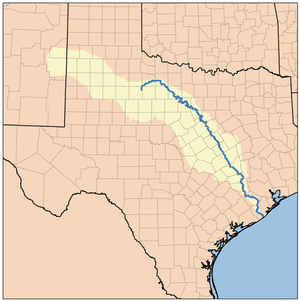Deadose
The Deadose were an Indian Tribe in present-day Texas closely associated with the Jumano, Yojuane, Bidai and other groups living in the Rancheria Grande of the Brazos River in eastern Texas in the early 18th century.

Like other groups in the Rancheria Grande, the Deadose moved to the San Gabriel River missions in the 1740s. The Deadose were along with the Yojuane, Mayeye and Bidai those who requested the Franciscan missionaries to come and set up missions for them.[1] However many of the Deadoseas as well as the Bidai and Akokisa only went to the vicinity of the missions to trade with the soldiers. They also had set up trade networks that extended to the French in Louisiana.[2] In 1750 the Deadose and their Bidai and Akokisa associates at Mission San Ildefonso left in an alliance with Ais, Hasinai, Kadohadachos, Nabedaches, Yojuanes, Tawakonis, Yatasis, Kichais, Naconis and Tonkawas to attack the Apache. The Deadose did not come back to the mission until 1752.[3]
In the mission the Deadose intermarried heavily with the Akokisa and Bidai.[4]
Notes
- Barr, Peace Came in the Form of a Woman, p. 131
- Anderson, The Indian Southwest, p. 86
- Barr, Peace Came in the Form, p. 146
- Barr, Peace Came in the Form, p. 156-157
References
- Anderson, Gary Clayton. The Indian Southwest. Norman: University of Oklahoma Press, 1999.
- Barr, Juliana. Peace Came in the Form of a Woman: Indians and Spaniards in the Texas Borderlands. Chapel Hill: University of North Carolina Press, 2007.